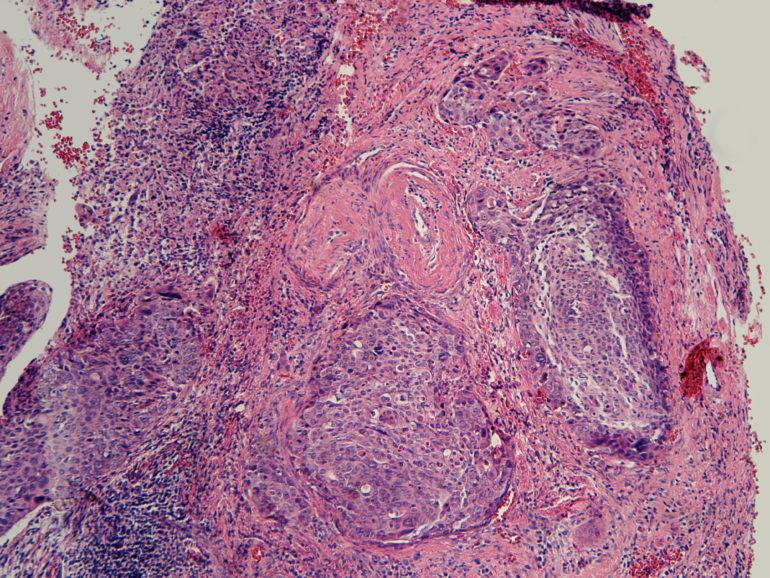What are Cervical Cancer Cellular Types? What are the Differences?
When we talk about the cellular types of the cervical cancer, we understand “Histopathological Types”. Meaning, we indicate the different cell types causing the cervical cancer. The data you will see below are taken from UpToDate site and we think that there is no reason for the cervical cancer cases in our country to present a different profile.
However during the years the rates of occurring of these cell types are varied. The most commonly seen cell type in cervical cancers is “Squamous Cell Cervical Cancer.”
According to the latest data in all the cervical cancer cases, 69% of the cases are formed of squamous cell carcinoma, 25% of adenocarcinoma, 6% of other types (Ries LAG, Melbert D, Krapcho M, et al. SEER Cancer Statistics Review, 1975-2004. National Cancer Institute; Bethesda 2007).
Within the 6% frequently there are adenosquamous cell cervical cancers prevail.
The histopathological types detected in cervical cancers, meaning cell types, are important data for us that shape the clinical progress. Despite that the information I shall list below are academic, who knows, you may find them interesting.
If we need to list the differences between us:
1. There are differences between the HPV types causing the squamous cell cervical cancer and the others. The HPV types causing squamous cell carcinoma are, in order, 59% HPV type 16, 13% HPV type 18, 5% HPV type 58, 5% HPV type 33, 4% HPV type 45 positive.
However in the tumors of the patients with cervical adenocarcinoma 36% HPV type 16, 37% HPV type 18, 5% HPV type 45, 2% HPV type 31, 2% HPV type 33 are positive (Li N., Franceschi S., Howell-Jones R. et al. Human papillomavirus type distribution in 30,848 invasive cervical cancers worldwide: Variation by geographical region, histological type and year of publication. Int J Cancer. 2011;128(4):927).
As seen, HPV type 18 is seen more in adenocarcinomas.
2. Cell types also change the clinic. It is really hard to determine cervical adenocarcinomas in early stages. These can cause tumors that are not seen from outside and sometimes can be missed with smear and root at the section of the cervical canal close to the womb.
3. Squamous cell carcinoma and adenocarcinoma have no difference between them regarding illness free life period and total life times when proper treatments are applied.
On the other hand, the advanced stage adenosquamous cell cervical cancers are bad for prognosis.
Bu saydıklarımıza ek olarak histopatolojik tiplerde değişmektedir. In addition to what we listed, the histopathological types also change. For example, while I was an assistant (25 years ago, as you see I am getting older 😊) the frequency of squamous cell carcinoma was 80%, however this ratio is given as 69% now. The adenocarcinoma frequency among the cervical cancers is gradually increasing.
The reasons of this increase are speculative. For me, one of the most important one is that detection of the squamous cell cervical cancers is easier especially due to increasing scanning methods but adenocarcinomas can be missed.
Another view stressed is that the HPV types have different variants. Meaning, it is claimed that the new subtypes of HPV Type 16 and 18 cause more adenocarcinomas. In long term, it seems that there will be more studies on the differences occurring at the subgroups of HPV types. However my favorite view that I believe to be valid today is that the chance to miss the adenocarcinomas is high and we can detect the squamous cell cancer precursors before they turn to cancers and cure them with the pap-smear.
In summary, when the cervical cancer is in question, the most frequently seen cell type is squamous cell carcinomas. The HPV types causing cervical cancer most frequently are Type 16 and 18.
The cell type of the tumor (the tumor histopathology) does not affect the survival of the patient in early stage cervical cancers with proper treatments. Whereas in advanced cervical cancers, the prognosis of the adenosquamous cell cancers is bad (Grisaru D., Covens A., Chapman B. et al. Does histology influence prognosis in patients with early-stage cervical carcinoma? Cancer. 2001 Dec 15;92(12):2999-3004) (Farley J.H., Hickey K.W., Carlson J.W., Rose G.S. et al. Adenosquamous histology predicts a poor outcome for patients with advanced-stage, but not early-stage, cervical carcinoma. Cancer. 2003 May 1;97(9):2196.)
3 Eylül 2017 tarihinde Prof. Dr. Süleyman Engin Akhan tarafından yayınlanmış ve 19 Kasım 2018 tarihinde de son güncelleme yapılmıştır.

